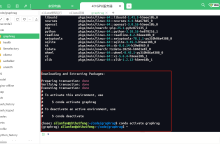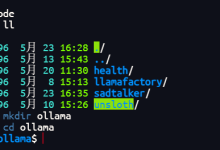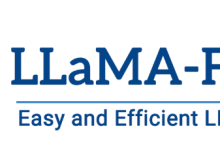基于DeepSeek-R1-Distill-Llama-8B的健康管理助手微调过程
本次创新实训项目的主要任务是利用DEEPSEEK提供的开源模型,通过微调技术,实现一个专注于健康管理与医疗咨询的人工智能助手。本文详细记录我们如何对DeepSeek-R1-Distill-Llama-8B模型进行微调,以满足健康医疗领域应用的需求。
为什么选择DeepSeek-R1-Distill-Llama-8B?
我们选择DeepSeek-R1-Distill-Llama-8B模型主要基于以下原因:
- 模型规模合适:8B参数规模在GPU资源有限的条件下也能高效训练。
- 中文理解能力强:特别适合医疗咨询类问题,语言表述清晰且专业。
- 开放与自由:DeepSeek系列的开源特性让我们能灵活地微调和部署。
数据集的选择和介绍
我们使用的是FreedomIntelligence医疗推理数据集。该数据集专注于医疗推理任务,每条数据由以下三个部分组成:
- Question:医学问题描述。
- Complex_CoT:详细的医学推理过程。
- Response:医学建议或诊疗方案。
数据示例:
{
"Question": "一个患有急性阑尾炎的病人已经发病5天,腹痛稍有减轻但仍然发热…",
"Complex_CoT": "考虑病程较长,阑尾可能已形成脓肿,需要进一步处理…",
"Response": "建议首先进行保守治疗,如有必要再考虑手术干预。"
}
LoRA 微调原理详解
LoRA (Low-Rank Adaptation) 是一种高效的微调技术,通过冻结原模型的参数,仅通过低秩矩阵来适应新任务。具体而言,LoRA在原始权重矩阵
W
0
∈
R
d
×
d
W_0 \\in \\mathbb{R}^{d \\times d}
W0∈Rd×d 基础上,增加了两个低秩矩阵
A
∈
R
r
×
d
A \\in \\mathbb{R}^{r \\times d}
A∈Rr×d 和
B
∈
R
d
×
r
B \\in \\mathbb{R}^{d \\times r}
B∈Rd×r,实现权重微调:
Δ
W
=
B
A
(
r
≪
d
)
\\Delta W = BA \\quad (r \\ll d)
ΔW=BA(r≪d)
实际更新后的权重表示为:
W
=
W
0
+
B
A
W = W_0 + BA
W=W0+BA
LoRA的参数设置包括:
- r (rank):控制模型微调的容量与精度,通常取8至64。
- lora_alpha:放大系数,用于调整LoRA微调的学习强度,通常与r取相近数值。
通过LoRA,能够极大降低训练成本与显存占用,仅用少量参数即可有效微调。
微调实现过程
环境配置
!pip install unsloth bitsandbytes transformers datasets trl
模型加载与量化
使用Unsloth进行高效加载(使用4-bit量化):
from unsloth import FastLanguageModel
model, tokenizer = FastLanguageModel.from_pretrained(
"unsloth/DeepSeek-R1-Distill-Llama-8B",
max_seq_length=2048,
load_in_4bit=True
)
数据集处理
构建适合模型微调的Prompt模板:
from datasets import load_dataset
EOS = tokenizer.eos_token
def formatting_prompts_func(examples):
texts = []
for q, cot, ans in zip(examples["Question"], examples["Complex_CoT"], examples["Response"]):
text = f"""Below is an instruction…
### Question:
{q}
### Response:
<think>
{cot}
</think>
{ans}{EOS}"""
texts.append(text)
return {"text": texts}
dataset = load_dataset(
"FreedomIntelligence/medical-o1-reasoning-SFT",
'zh',
split="train[:500]"
).map(formatting_prompts_func, batched=True)
LoRA微调参数配置
model = FastLanguageModel.get_peft_model(
model,
r=16, # 设定秩大小
lora_alpha=16, # LoRA放缩因子
target_modules=["q_proj", "k_proj", "v_proj", "o_proj", "gate_proj", "up_proj", "down_proj"],
use_gradient_checkpointing="unsloth"
)
微调训练
使用TRL库的SFTTrainer进行高效训练:
from trl import SFTTrainer
from transformers import TrainingArguments
trainer = SFTTrainer(
model=model,
tokenizer=tokenizer,
train_dataset=dataset,
dataset_text_field="text",
args=TrainingArguments(
per_device_train_batch_size=2,
gradient_accumulation_steps=4,
max_steps=60,
learning_rate=2e-4,
fp16=True,
output_dir="outputs",
logging_steps=1
)
)
trainer.train()
微调后模型简单推理验证
FastLanguageModel.for_inference(model)
question = "“最近感觉睡眠质量差,晚上容易醒来,白天精神也不好,应该如何调理?"
inputs = tokenizer([question], return_tensors="pt").to("cuda")
outputs = model.generate(
input_ids=inputs.input_ids,
attention_mask=inputs.attention_mask,
max_new_tokens=1024
)
response = tokenizer.decode(outputs[0], skip_special_tokens=True)
print(response)
通过上述过程,可以初步看到我们微调后的模型,在医疗问题回答的逻辑性和专业性上明显优于未经微调的模型,这验证了LoRA微调方法和我们整体微调流程的有效性。
总结
本文介绍了我们项目中如何基于DeepSeek-R1-Distill-Llama-8B模型,采用LoRA技术及医疗推理数据进行高效的微调训练。这为后续“健康管理助手”智能体的开发和应用提供了重要的基础。
 网硕互联帮助中心
网硕互联帮助中心







评论前必须登录!
注册